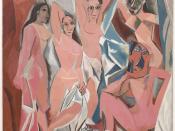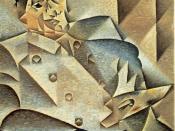Juan Gris (born Jose Victoriano Gonzalez) was brought up in Madrid 1887;; in 1906 he fled to France to avoid military conscription, where he joined the circle of avant-garde poets and artists (which included Braque). His first works were post-impressionist still life but he soon eagerly followed the path towards abstraction right behind Picasso and Braque and converted to cubism. Cubism dated back to the beginning of the 20th century, it was a turning point in the modern art and with its different ideals it confused many artists. It was established for a synthetic purpose, so that when an image was depicted its views were not limited and it would be able to be viewed simultaneously with multiple perspectives. In 1911 Gris followed this shifting trend and began to produce analytical works. Eventually his works began to acquire certain uniqueness, which was the due to Gris' own conception of cubism.
He believed in creating and explanation of forms rather than a complication, he expresses this approach in his remark about Cezanne ~ "Cezanne made a cylinder out of a bottle. I start from the cylinder to create a special kind of individual object, I make a bottle out of a cylinder..." the cubist movement had now moved from analytical to synthetic and Gris was one of its strongest supporters. Gris lived a concise and miserable life, suffering chronic depression, implications of war and a physical illness. He was highly dedicated to his work and had a strong passion for art. He died at the age of 40 in 1927.
Juan Gris work "The violin" 1916 is composed with few objects, overlapping in colour planes and balanced diagonals. The composition is focused on a musician's violin, stool, music sheet and bow. The picture appears to be sombre and depressing with dull...


